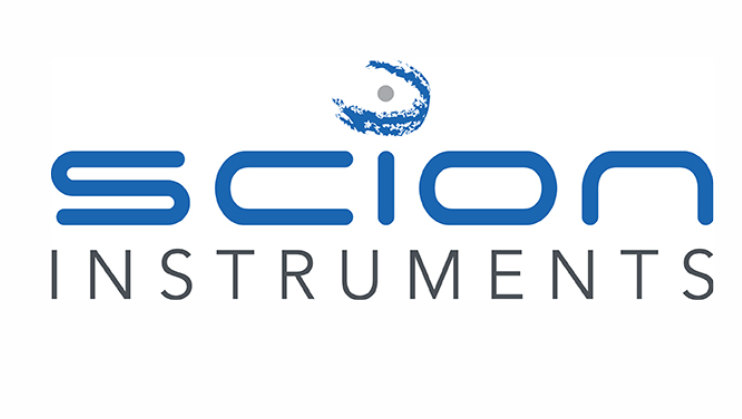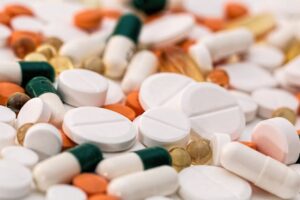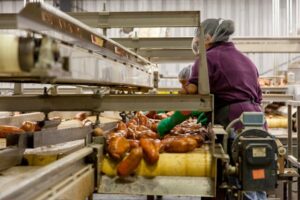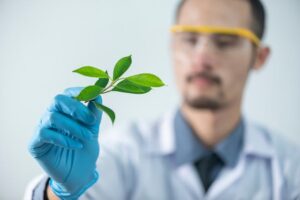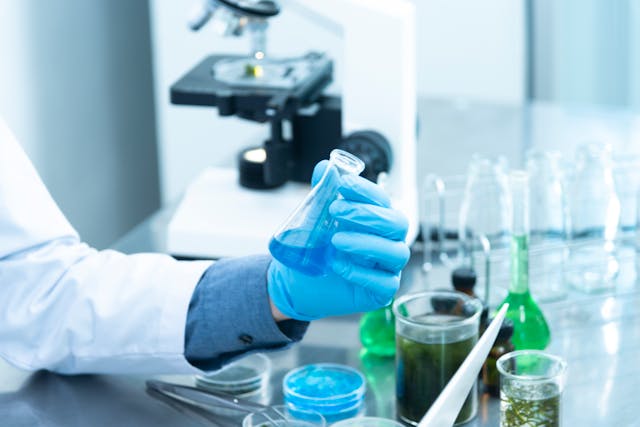Liquid Chromatography:
How It Works and Real-World Applications
Ever wondered how laboratories make sure the drugs you take are safe or how food manufacturers check for contaminants? The answer to both of these questions—and many more—lies in a powerful technique called Liquid Chromatography (LC). This method is widely used in labs to separate and analyse different substances in a mixture, ensuring everything is up to standard.
Whether you’re in the pharmaceutical industry, working in food safety, or testing the quality of the air or water around you, liquid chromatography is likely playing a key role in ensuring accuracy and safety. In this article, we’ll break down how liquid chromatography works and explore the many real-world applications it has across industries.
For a general overview, on the topic of Chromatography see our guide “Chromatography Explained“, or read about “Gas chromatography”
What is Liquid Chromatography?
Simply put, Liquid Chromatography (LC) is a technique used to separate and analyse different components in a mixture. Think of it as a lab tool that helps scientists break down complex mixtures into their individual parts, which is crucial for testing everything from the purity of medicines to the quality of food and water. By using a liquid solvent, LC allows scientists to “sort” substances based on how they move through a system.
In practical terms, liquid chromatography helps answer questions like: Is this drug pure? Are there harmful substances in this food sample? How clean is the water you’re drinking? LC plays a crucial role in answering those questions, ensuring safety and quality.
How Does Liquid Chromatography Work?
The beauty of liquid chromatography lies in its ability to separate different substances from one another. Here’s how it works in the simplest terms:
- Mobile Phase: This is the liquid solvent that carries the sample through the system.
- Stationary Phase: This is typically a solid material (like tiny beads) that’s packed inside a column, and it interacts with the components of the mixture, slowing them down at different rates.
- Separation: As the mobile phase moves through the stationary phase, the different components of the sample move at different speeds. Some components stick to the stationary phase more than others, causing them to separate and travel at different rates. This separation allows scientists to identify and quantify the individual substances in the mixture.
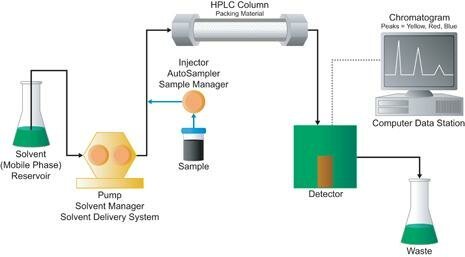
Think of it like a race: the mobile phase is the starting line, the stationary phase is the track, and each substance in the mixture is a runner. Some runners (substances) take longer to finish the race because they’re more “sticky” and slow down, while others zip through faster.
Aspect | Liquid Chromatography | Gas Chromatography |
Mobile Phase | Liquid solvent (water, organic solvents, etc) | Gas (usually helium or nitrogen) |
Sample Type | Non-volatile, liquid samples( e.g proteins, pharmaceuticals) | Volatile compounds (e.g gases, solvents, essential oils) |
Typical Applications | Pharmaceuticals, food testing, environmental analysis, biotechnology | Petroleum, forensic analysis, fragrance, environmental analysis |
Common Industries | Pharmaceutical, food and beverage, environmental testing, chemical analysis | Oil and gas, forensics, flavour and fragrance industries |
Sample Preparation | Samples can be complex mixtures, biological fluid or liquid extracts | Samples are typically gases or liquids that are easily vaporised |
Temperature Requirements | Room temperature or moderate heating | High temperature for vaporisation of the sample |
Column Type | Packed or analytical columns ( often longer for high resolution) | Capillary columns( typically smaller and shorter) |
Sensitivity | High sensitivity to a wide variety of compounds | High sensitivity for volatile compounds |
Choice of Method | Best for complex, non – volatile mixtures | Ideal for simple, volatile compounds that evaporate easily |
Types of Liquid Chromatography Systems
Liquid chromatography (LC) is a critical technique in the analytical sciences for separating and quantifying compounds in complex mixtures. These methods are utilised extensively across industries like pharmaceuticals, environmental analysis, food and beverage, and biochemistry. The primary goal of analytical chromatography is to achieve high resolution and accuracy in the separation of analytes for identification and quantification.
1. High-Performance Liquid Chromatography (HPLC)
High-Performance Liquid Chromatography (HPLC) is a cornerstone of analytical liquid chromatography. It uses high-pressure pumps to force a liquid mobile phase through a column packed with a stationary phase, which separates the sample into its individual components. HPLC is highly valued for its precision, sensitivity, and versatility, making it ideal for a wide range of analytical applications, from routine quality control in pharmaceutical manufacturing to complex bioanalytical tests.
Key Applications:
- Pharmaceutical Analysis: For determining the purity, content, and stability of drug compounds.
- Environmental Testing: Detecting trace pollutants in water, air, and soil samples.
- Forensic Toxicology: Quantifying drugs, metabolites, and other chemicals in biological samples.
HPLC can be customised for specific applications through various stationary phases (e.g., reverse-phase, normal-phase, ion-exchange, size-exclusion), depending on the properties of the analytes being studied.
2. Ultra-High-Performance Liquid Chromatography (UHPLC)
Ultra-High-Performance Liquid Chromatography (UHPLC) builds upon the principles of HPLC but uses smaller particle sizes for the stationary phase (less than 2 µm), which allows for faster, more efficient separations. The smaller particles increase the surface area for interactions with the analytes, leading to improved resolution and shorter analysis times. UHPLC operates under higher pressure than traditional HPLC, making it ideal for high-throughput analysis where speed and resolution are critical.
Key Applications:
- Pharmaceutical Quality Control: In high-throughput environments to test large batches of pharmaceutical products.
- Proteomics and Metabolomics: For analysing complex biomolecular samples with improved sensitivity and resolution.
- Environmental and Food Safety: Rapid analysis of contaminants and additives in complex matrices.
3. Ion Chromatography (IC)
Ion Chromatography (IC) is a specialised form of liquid chromatography used to analyse ions—both anions and cations—in a sample. The separation is based on the interactions between the ions and an ion-exchange resin within the column. IC is particularly powerful for analysing ionic substances in water, soil, and environmental samples.
Key Applications:
- Environmental Monitoring: Determining the concentration of ions such as chloride, sulphate, nitrate, and heavy metals in environmental samples.
- Water Quality Testing: Measuring trace levels of anions and cations in drinking water, wastewater, and natural water sources.
- Food and Beverage Industry: Testing for ionic contaminants in food products.
IC can also be coupled with conductivity detectors, which measure the changes in electrical conductivity as ions pass through the detector, enabling sensitive detection even at low concentrations.
4. Size-Exclusion Chromatography (SEC)
Size-Exclusion Chromatography (SEC), also known as gel filtration chromatography, separates molecules based on their size. In this technique, the stationary phase consists of porous beads, and larger molecules elute from the column first because they do not enter the pores as readily as smaller molecules. SEC is particularly useful for characterising the size distribution of large molecules such as proteins, polysaccharides, and synthetic polymers.
Key Applications:
- Protein Purification and Characterization: Determining the molecular weight and size distribution of proteins or biopolymers.
- Polymer Science: Analysing the molecular weight distribution of synthetic polymers.
- Biotechnology: Characterising large biomolecules such as antibodies, enzymes, or gene therapies.
SEC is often used as a complement to other techniques such as HPLC and mass spectrometry in the comprehensive analysis of complex biological samples.
5. Reversed-Phase Liquid Chromatography (RPLC)
Reversed-Phase Liquid Chromatography (RPLC) is a specific type of HPLC in which the stationary phase is nonpolar (hydrophobic), while the mobile phase is polar. This type of chromatography is widely used for the separation of hydrophobic compounds, such as small organic molecules, peptides, and proteins. RPLC is highly popular due to its robustness, reproducibility, and effectiveness for a wide range of applications.
Key Applications:
- Pharmaceutical Analysis: For quantifying APIs, excipients, and metabolites in drug formulations.
- Peptide and Protein Analysis: Separating and purifying peptides or proteins for further study.
- Clinical and Forensic Analysis: Detecting trace organic substances in blood, urine, or tissue samples.
RPLC provides excellent resolution and is often the first choice for analytical separations in both research and industrial settings.
Key Applications of Liquid Chromatography
Liquid chromatography (LC) has revolutionised many fields by enabling precise separation and quantification of compounds, thus contributing significantly to scientific advancements and solving real-world problems. Below are several specific examples of how liquid chromatography, particularly High-Performance Liquid Chromatography (HPLC), has been used in various industries to improve human health, safety, and environmental sustainability.
Pharmaceutical Industry : Quality Control in Cancer Treatment Drugs
HPLC has played a critical role in ensuring the purity and dosage of life-saving cancer treatment drugs. For example, HPLC is used in the production and analysis of anticancer agents like paclitaxel (Taxol), a chemotherapy drug derived from the Pacific yew tree. The precision offered by HPLC ensures that the drug is free from harmful impurities and is manufactured in the correct dosage, which is crucial for the effectiveness and safety of the treatment.
Case Study : Paclitaxel Production: HPLC has been used extensively in the production process of paclitaxel to confirm the identity, purity, and potency of the compound, ensuring the safety and efficacy of chemotherapy treatments for cancer patients.
Source: “Validated HPLC Method for the Determination of Paclitaxel”
Environmental Analysis: Monitoring Pesticide Residues in Water
In environmental analysis, liquid chromatography is essential for detecting pesticide residues in natural water sources, which is crucial for ensuring safe drinking water. For instance, HPLC coupled with mass spectrometry (HPLC-MS) is used to identify trace amounts of pesticides such as glyphosate in rivers, lakes, and groundwater.
Case Study : Pesticide Residue Analysis: A study conducted in the Amazon River utilised HPLC to measure pesticide residues, with findings showing contamination from agricultural runoffs. This directly impacts public health, as exposure to high levels of pesticides can lead to various diseases, including cancer.
Source : “Ecological risk assessment of pesticides in urban streams of the Brazilian Amazon“
Food and Beverage Industry: Detection of Food Additives
Liquid chromatography is also a key tool for analysing food additives, preservatives, and contaminants to ensure food safety. For example, the detection of sodium benzoate, a common preservative used in soft drinks, has been effectively carried out using HPLC.
Case Study : Beverage Contaminants: In the 2010s, a global study utilised HPLC to analyse soft drink samples from various regions for the presence of preservatives like sodium benzoate. The study helped establish safe consumption limits and prompted regulatory changes in several countries to limit its use due to potential health risks like hyperactivity in children.
Source : Simultaneous Determination of Six Preservatives in Beverage by HPLC
Forensic Science: Drug Detection in Toxicology
In forensic toxicology, liquid chromatography is crucial for detecting drugs of abuse in blood, urine, or other biological samples. HPLC is routinely used to identify illicit substances such as opioids, cocaine, and methamphetamine in toxicology screenings, especially in forensic investigations following overdose deaths.
Case Study:
- Opioid Overdose Investigation: The rise of opioid overdoses in the United States has led to increased use of HPLC for opioid detection. A 2017 study used HPLC to identify fentanyl and its analogs in overdose victims, helping authorities understand the opioid crisis and provide evidence for legal cases.
Biotechnology: Proteomics and Biomarker Discovery
In biotechnology, HPLC is vital for analysing proteins and peptides in proteomics research. It aids in the discovery of biomarkers for diseases like Alzheimer’s, providing insight into early diagnosis and personalised medicine.
Case Study : Alzheimer’s Disease Biomarkers: Researchers have employed HPLC coupled with mass spectrometry to isolate beta-amyloid peptides, a key biomarker of Alzheimer’s disease. The discovery and analysis of these biomarkers through HPLC have been instrumental in developing diagnostic tests for early-stage Alzheimer’s, contributing to better outcomes for patients through early intervention.
Source : Plasma metabolic profiling of Alzheimer’s disease by liquid chromatography/mass spectrometry
Biochemical Manufacturing: Insulin Production
In the production of insulin, a hormone essential for managing diabetes, liquid chromatography is used to purify the recombinant insulin produced in genetically engineered bacteria. HPLC techniques are employed at multiple stages of production to ensure the purity of the final product, preventing any harmful impurities from reaching the consumer.
Case Study : Recombinant Insulin Production: HPLC is used to purify insulin during the manufacturing process, ensuring that patients receive a safe, pure, and effective product. Over 400 million people globally rely on insulin, and HPLC guarantees that only the highest-quality product is delivered, reducing the risk of adverse effects.
Source : Expression and purification of recombinant human insulin from E. coli 20 strain
Liquid chromatography, especially HPLC, is essential across healthcare, environmental science, food safety, and biotech due to its unmatched precision and reliability.
To support these industries, Smart Labtech provides advanced chromatography systems and specialised columns from Waters Corporation, empowering labs to deliver high-quality results that drive innovation and industry progress.
For any product enquiries please reach out to marketingsupport@smartlabtech.net or call us at 72888 88016


